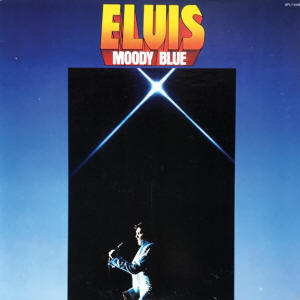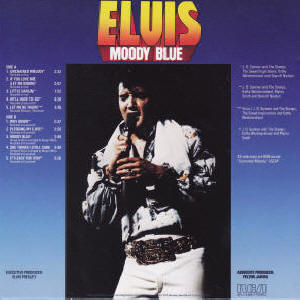

When "Moody Blue" hit the stores in July 1977
it had been over a year since RCA Records had
released a Presley album with new songs. To
promote the release, the company pressed the
first 250,000 copies on blue vinyl. On July 23rd
"Moody Blue" entered Billboard's "Top LPs Chart"
where it peaked at number 24. On the "Hot
Country LPs Chart" the album became a number one
hit.
The comparably high ranking on the "Top LPs
Chart" indicates that "Moody Blue" sold better
than "From Elvis Presley Boulevard, Memphis,
Tennessee" and maybe would have moved 2.5
million units if Elvis had not died. However,
when he passed away there was a huge request for
the album and RCA Records switched the
production of their pressing plant in
Indianapolis completely to "Moody Blue", once
again using blue vinyl. On the "Top LPs Chart"
the album climbed to number three, on the "Hot
Country LPs Chart" it kept his number one
position for a solid ten weeks. In December 1977
the RIAA honored the US sales with a Gold Award,
in 1992 it was updated to Double Platinum.
Abroad "Moody Blue" also was quite popular and
sold 8 million units worldwide. Today that would
be 1.2 billion paid streams of the whole album
or 128 billion paid streams of individual songs!
In 2016 the complete Presley catalogue was
restored and remastered by Vic Anesini for a
boxed set of 60 compact discs called "The Album
Collection". Sony Music Entertainment provides
the streaming platforms with the same versions
of the individual albums (some of them offering
bonus tracks), albeit in 24 bit/90 khz flac.
That means, if the platform of your choice
supports high resolution audio, you can enjoy
the tracks in the same quality Sony used to scan
and master them. On Spotify, which has a market
share of approximately 30% and is the only
platform that publishes streaming figures,
"Moody Blue" accumulates 170 million streams.
The compilation album "Way Down In The Jungle
Room", which was released in 2016 and features
remixed and remastered versions of the tracks as
well as outtakes, clocks in at nearly 120
million streams. So Elvis' final studio
recordings remain a popular item.
For the album cover RCA Records used two
pictures made way back in 1972. The one on
the front was shot in November, the photo on the
back in June.
In 2013 Sony's own collectors label Follow
That Dream Records released a classic album
edition of "Moody Blue". Besides the masters of
the original album this special edition also
includes studio outtakes and additional live
recordings. For whatever reason FTD sticks to
the dying compact disc format and doesn't
release their products digitally. So the classic
album is not available for streaming. Tap
HERE for the review.
As written in the article regarding the album
"Welcome To My World", Elvis was supposed to
deliver 24 new masters in February 1976.
Unfortunately he just completed 12 tracks,
leaving RCA Records with two unreleased songs
after the album "From Elvis Presley Boulevard,
Memphis, Tennessee" was compiled. So there was
another recording session in October. To meet
the contract with RCA an additonal 12 tracks
were needed, but considering they already had 2
unreleased songs in the can I guess everybody
would have been happy to get another eight
masters to be able to release another album.
This time it went even worse, Elvis didn't
finish more than 4 songs. As a result there was
a third session in January 1977 at Creative
Workshop in Nashville, but this time the singer
didn't show up at all. Finally producer Felton
Jarvis accompanied Elvis on tour in March and
April, using an old fashioned 4-track recorder
and hoping to catch some songs not featured on
one of the many live albums of his employer.
Finally he was able to come up with an album of
ten songs and a running time of 31:35 minutes.
Unchained Melody
The first track was recorded on April 24, 1977
at the Crisler Arena in Ann Arbor/Michigan. On
stage Elvis accompanied himself on piano, the
band just added little touches here and there.
On May 9th and June 9th Felton Jarvis added
bass, percussion and a moog synthesizer. Because
the king wasn't a very good piano player, Bobby
Odgin re-recorded the part. Sherrill Nielsen was
on hand to fix the final note of the song, which
Elvis had missed on stage. As a final step the
harmony voices were braught to the fore. The
result was some kind of miniature opera. Very
kitschy, but also very impressive. The
"Unchained Melody" was the title song of a movie
named "Unchained" in 1955. The original
performer is Todd Duncan, but there are more than
500 (!) cover versions of this song. The best
known was released by the Righteous Brothers and
became a massive hit in 1990 when it was used in
the blockbuster movie "Ghost". The arrangement
is 100% different to Elvis' version, because it
lacks all the drama and bombast the king put
into it.
If You Love Me (Let Me Know)
In 1974 the country pop had been a top10 hit for
Olivia Newton-John and Elvis picked it up for
his stage show almost immediately. It was
written by John Rostill, the recording on this
album was made on April 25, 1977 at the Civic
Center in Saginaw/Michigan. On May 9th Felton
Jarvis added a few instruments to beef it up a
bit. If one doesn't listen too closely the
performance is quite nice. But compared to the
similar "Let Me Be There" (recorded on March 20,
1974), it's obvious that Elvis sounds somewhat
sluggish and tired.
Little Darlin'Just like
"Unchained Melody" this was recorded in Ann
Arbor on April 24, 1977. On May 9th additional
instruments and backup voices were added. Elvis
didn't take this song seriously, it was some
kind of musical comedy, a piece to have fun with
and an opportunity to use his falsetto. Such a
performance certainly is entertaining
in a concert but it's unsuitable on a record
like this. It's obvious that the release of
"Little Darlin'" is nothing but an act of
desperation. By the way, the song was written by
Maurice Williams, who recorded it with his band,
The Gladiolas. However, the big success was by The
Diamonds. In 1957 their version became a number
2 hit on the "Top 100".
He'll Have To GoOn October
30, 1976 Elvis and the band were supposed to
record some more songs in the den of the king's
"Graceland" mansion, but the singer refused to
leave his bedroom. So the musicians recorded
rhythm tracks to which Elvis could add his
vocals on a later date. He did it the very next
day, as it turned out this would be his final
"studio" recording. On April 7, 1977 Felton
Jarvis added a guitar. The song was written by
Joe and Audrey Allison and recorded in 1957 by
Billy Brown. While this original rendition
wasn't successful at all, the cover version by
Jim Reeves held the top position of Billboard's
Country Chart for 14 weeks and became one of the
best sellers of this genre. In the song the
narrator is phoning his lady and wants her to
decide between him and another man. Elvis sounds
sad and a little tired. He doesn't fight for
her, he just wants a decision. I like Elvis'
performance very much, "He'll Have To Go" is one
of my favorites on this album.
Let Me Be ThereThe
similarity to "If You Love Me (Let Me Know)" is
no coincidence, both songs were written by John
Rostill for Olivia Newton-John. The use of this
track is another desperate act, because it
already had been released in 1974 on "Elvis
Recorded Live On Stage In Memphis".
Way Down
The filler is followed by the current single of
the king. On the country chart the track became
a number 1, but on the more important "Hot 100"
it didn't make it past the Top40. "Way Down" was
written by Layng Martine jr, Elvis recorded it
on October 29, 1976 at the den of "Graceland"
mansion. The master take is numbered 2c, because
Felton Jarvis messed up the counting. If it had
been correct, it would have been take 5. On
January 22, 1977 the producer added harmony
vocals. I would describe "Way Down" as an
uptempo popsong with retro rock'n'roll elements.
It could have been great if Elvis had invested a
little more energy. It's still a nice track, but
also a missed opportunity.
Pledging My LoveOn the same
day Elvis also recorded "Pledging My Love". In
contrast to his somewhat tired performace of the
rocker this country ballad is sung with emotion
and enthusiasm. To me this one is another
highlight. The song was written by
Ferdinand Washington and Don Robey and first
performed in 1955 by Johnny Ace. According to
some rumors the song was also on the set list of
the young Mr. Presley. Twentyone years later he
needed six takes to put the country ballad on
tape. On January 22, 1977 Felton Jarvis added
additional vocals and instruments and shortened
the recording of two and a half minutes. RCA
Records first released "Pledging My Love" on the
flipside of "Way Down".
Moody BlueMark James wrote
and recorded the song in 1974, but it wasn't
successful at all. On February 4, 1976 Elvis put
the song on tape in the den of his "Graceland"
mansion within 10 takes. Later Felton Jarvis
added bass (February 15, 1976), drums (February
17, 1976), guitars (February 24, 1976) and
strings (February 24, 1976). He also shortened
the recording of 1.5 minutes. The result was
released in November 1976 and became a number
one hit on the "Hot Country Singles Chart" in
early 1977. Here the singer struggles with his
relationship with an inconsistently acting lady.
He does it in form of a popsong with disco
elements, which was quite popular back then. The
style is atypical for Elvis, but works very
well.
She Thinks I Still CareThe
b-side of "Moody Blue" was first released in
1962 by George Jones. In Dickey Lee's song the
narrator was left by his lady, but refuses to
admit that he still loves her. On February 2,
1976 Elvis toiled through 19 takes (because the
numbers 2 and 12 were used twice the official
master take is number 17), but still the final
version includes several vocal shortcomings.
Nevertheless the king sounds impressive at times
and delivers the country ballad in a very
emotional and believable way.
It's Easy For YouThe singer
once left his family for another woman, but now
she is leaving him and he has to realize that
it's much harder for him than it is for her.
Elvis nails the song, vocally and emotionally
it's an outstanding performance. Many fans and
critics dislike "It's Easy For You", but I
consider it a highlight. It was written by Tim
Rice and Andrew Lloyd-Webber and recorded by
Elvis on October 29, 1976 at his "Graceland"
mansion within 4 takes. The king selected take 2
for post-production and release. The final step
was a guitar overdub on April 6, 1977.
Verdict
With five out of ten tracks already known
and another three being recorded live out of
sheer desparation "Moody Blue" is nothing
but an admission of defeat for a major
recording artist like Elvis Presley.
Nevertheless Felton Jarvis managed to
compile an astonishingly strong album with
several highlights.

(C) RCA Victor
![]()

